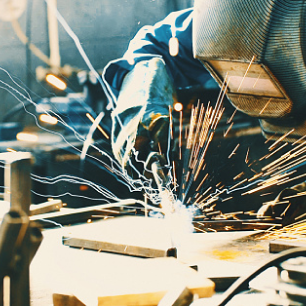Jump to:
Weld Joint Design and Process Practice Improvements
Continuous improvement initiatives make a difference in driving the changes necessary to improve status quo processes and practices while increasing quality, enhancing production efficiency, and lowering costs. Figure 1 illustrates a vertical support beam consisting of a stiffening cover plate manually welded between two beam flanges that required nondestructive examination (NDE), which included visual testing (VT), magnetic particle testing (MT), and ultrasonic testing (UT). These processes are hereafter referred to as NDE. Based on previous weld joint design and process practices, achieving NDE-acceptable welds with 100% root weld penetration and beam flange sidewall fusion proved challenging.
Also, in the rewelding of the cutoff beam flange to the tapered beam web, it was difficult to achieve weld joint offset within the maximum permissible limits as specified within Naval Sea Systems Command (NAVSEA), MIL-STD-2035A (SH), Nondestructive Testing Acceptance Criteria.
The process used for welding was manual pulsed gas metal arc welding (GMAW-P) spray transfer mode. Fabrication documents encompassed the client’s project weld specification, with NDE acceptance criteria in accordance with MIL-STD-2035A (SH). These included MIL-STD-22D, Department of Defense Design Criteria: Welded Joint Design; and NAVSEA S9074-AR-GIB-010/278, Requirements for Fabrication Welding and Inspection, and Casting Inspection and Repair for Machinery, Piping, and Pressure Vessels.
Weldment Background
As specified by ASTM International A36, Standard Specification for Carbon Structural Steel, vertical support beams are used for marine gas turbine power-generation modules. Weld joint members were comprised of the vertical support beam, which was a modified, commercial wide flange beam (W10 × 33) in accordance with ASTM A6, Standard Specification for General Requirements for Rolled Structural Steel Bars, Plates, Shapes, and Sheet Piling. One beam flange was removed so the web width of the beam could be cut at a taper, and the flange was then rewelded back onto the web. Additionally, an A36, 0.500 in. thick × 29 in. long, tapered cover plate was fit up and welded between the beam flanges. The cover plate served as a structural stiffener plate.
The cover plate weld joint geometry was a complete joint penetration (CJP), single-bevel (45 deg) corner joint with a 0.0 in. root face. Seawater has the potential to enter the backside of the weld joint — Fig. 1. Consequently, a permanent weld backing could not be employed because seawater could get underneath the backing, resulting in corrosion of the root side of the weld.
Previous welding engineers employed a temporary, rectangular, ceramic weld backing that was removed after welding — Fig. 2. However, this proved to be detrimental in attaining acceptable NDE quality welds. As Fig. 1 illustrates, there is a nominal 3.375 in. between the beam web and the backside of the cover plate. The preceding welding engineers did not consider how root penetration would be achieved with the rectangular weld backing effectively blocking the root gap nor how root-pass and sidewall fusion would be attained (i.e., the depth of fusion into the beam flange).
PROCESS PRACTICE IMPROVEMENTS
In analyzing weld joint inspection failures, the two major weld discontinuities and defects were as follows: 1) achieving 100% root weld penetration and beam flange sidewall fusion during cover plate welding, and 2) achieving beam web and rewelded beam flange offset within the maximum permissible limits. The following process improvement initiatives were implemented:
- Utilizing rectangular, ceramic weld backing needed to be corrected. The rectangular geometry did not facilitate achieving NDE-quality corner joint welds with 100% root weld penetration and sidewall fusion. Thus, the rectangular, ceramic weld backing was replaced with a ceramic cylindrical backing at 0.375 in. diameter to facilitate the formation of a root penetration fillet contour and sidewall fusion — Fig. 5. The diameter of the ceramic cylindrical backing controls the amount of root sidewall fusion and the formation of a root penetration fillet contour (i.e., concave/miter). That is, as the cylindrical radius increases, the root penetration fillet contour increases and vice versa. Destructive weld tests of corner joint mockups and NDE provided engineering evidence that root side penetration and sidewall fusion could be attained consistently by employing ceramic cylindrical weld backing — Fig. 6.
- Employing the previous root gap of 0.125 in. was insufficient where a new, expanded root gap of 0.190 in. was established. The expanded root gap increased the root penetration weld pool flow and the depth of fusion into the beam flange.
- Grinding the weld joint to a bright, shiny metal finish to remove mill scale prior to welding was introduced. Mill scale inhibits weld pool fusion (i.e., washing) characteristics.
- Increasing weld metal soundness via the use of killed steels (a completely deoxidized steel) as opposed to the continued use of semikilled steels (a partially deoxidized steel). Weld metal porosity was observed during welding and NDE inspections. Also, because the manual GMAW-P spray process was used, an ER70S-6 at 0.035-in.-
diameter weld filler metal was specified with a 95% Ar/5% CO2 shielding gas. The chemical composition of the ER70S-6 welding wire includes higher levels of silicon (Si) and manganese (Mn) as opposed to ER70S-2, which serves as effective weld metal deoxidizers. - Welding was also performed slightly uphill at 15 deg in the 1G position within a fixture. Uphill welding increases penetration and weld pool fusion characteristics.
- Mitigating beam web and rewelded beam flange weld joint mismatch/offset by employing tooling to adjust the beam web height to better align the beam web to the beam flange during weld joint fitup. Based on the tooling design, the goal was to mitigate mismatch/offset to < 0.063 in. Welders and fitters were further trained on fitup techniques and practices. In addition, prior to welding, the weld joint fitup was inspected for mismatch. Emphasis was placed on the weld joint fitup and alignment to mitigate mismatch prior to welding and eliminate nonacceptable postweld offset.
- Preheating the weld joint area with an oxyfuel torch to a minimum of 100°F prior to imminent welding was introduced to drive out and remove moisture. Also, preheating facilitated weld pool fusion characteristics.
- Providing additional training to the welders relative to the welding technique involved repositioning the GMAW gun angle directly toward the beam flange such that arc energy was concentrated on the beam flange to achieve depth of fusion into the flange and sidewall fusion.
- Performing postweld NDE inspections while the weldment was still sitting within the production fixture and repairing/reworking welds as required.
- Note: The next scheduled process improvement includes the implementation of a mechanized GMAW system with a 75% Ar/25% CO2 shielding gas mixture as well as the utilization of two new specially designed ceramic weld backing geometries that facilitate achieving highly favorable root penetration fillet contours (i.e., a flat/mitered fillet contour, a convex radiused fillet contour).
Fabrication Problems
Based on the previous weld joint design and welding practices, there were two major recurring problems:
The cover plate, CJP, and single-bevel corner joint welds were regularly failing NDE because of incomplete root penetration and beam flange sidewall fusion. Welds were performed in the 1G position utilizing the manual GMAW-P process (95% Ar/5% CO2, ER70S-2 weld filler metal at 0.035 in. diameter). Incomplete penetration and sidewall incomplete fusion were occurring along each of the two 29-in.-long cover plate single-bevel corner joints. For VT inspection, a mirror was employed to examine the root side of the cover plate weld for penetration and sidewall fusion — Fig. 3.
The beam web to the rewelded beam flange was failing weld joint offset inspections — Fig. 4. As noted within MIL-STD-2035A (SH), paragraph 4.2.3, the maximum permissible offset for a base metal thickness over 0.250 to 0.750 in. equals 25% of the weld joint thickness where the beam web thickness equaled 0.295 in. This translates to a maximum permissible weld joint offset of 0.074 in. Utilizing a combination of bridge cam gauges or Reprorubber® metrology casting material, some postweld joint offsets were measured up to 0.236 in. Poor inspection results signified that decisive action was required to correct fabrication problems, increase weld and weldment quality and NDE, and improve first-time quality yields.
The Importance of Weld Backing
More emphasis must be placed on employing the correct weld backing geometry to achieve NDE structural quality welds. To facilitate CJP, single-bevel corner joint welds, the use of cylindrical backing supports the weld pool during welding, enabling welding to be carried out from a single side. With only 3.375 in. to the backside of the cover plate, root-side weld joint accessibility is not attainable, so properly using a ceramic weld backing geometry is required. For CJP, single-bevel corner joint welds, consideration must be given to the weld pool flow during root pass welding. That is, to achieve a high-integrity corner joint weld with complete root weld-bead penetration and sidewall fusion, the weld pool must be able to form a root penetration fillet contour and penetrate the beam flange to attain sidewall fusion. There are a multitude of ceramic weld backing geometries available, as well as backing tapes, depending on the weld joint design and application. Utilizing ceramic, cylindrical weld backing (e.g., 0.250–0.750 in. diameter) greatly facilitates sidewall fusion. Permanent and nonpermanent weld backing is an integral part of structural steel welding in facilitating fabrication and weld joint efficiency and in achieving mechanically sound, CJP, NDE quality welds.
Process Practice Improvement Results
As illustrated in Figs. 5–8, the work performed under the paragraph Process Practice Improvements resulted in resolving the two foremost production problems:
Achieving complete weld joint penetration and sidewall fusion on the beam flange; and
Attaining weld joint offset within the maximum permissible limits between the beam web and the rewelded beam flange. Welders were responsive and receptive to changes due to increased weld quality, as noted in Fig. 6. First-time NDE quality weld yields drastically improved and were achieved consistently.
It is important to initiate continuous improvement projects to improve and resolve ongoing production problems, increase first-time quality yields and production efficiency, and lower production costs. Welders were receptive to continuous improvement initiatives because these initiatives provided an opportunity for them to demonstrate their process improvement ideas, workmanship pride, and commitment to the quality of workmanship of the weldment. Welders wanted to contribute, and their input mattered.
To mitigate beam web and flange mismatch/offset, new tooling was designed and installed to support, align, and adjust the beam web height to the beam flange during fitup operations — Figs. 7, 8. Welders and fitters were also further trained in fitup techniques and practices. The aforementioned actions reduced weld joint mismatch/offset to < 0.063 in. The production process required attention to rectify prolonged weldment and weld quality problems.
Conclusion
Continuous improvement initiatives make a difference and drive change to improve from status quo processes and practices. Enough emphasis cannot be placed on devoting the time, energy, and resources to analyze the weld joint design and process practices, ensuring optimization in achieving weldment quality and first-time NDE quality welds consistently.
WILLIAM C. LAPLANTE (wlaplante.scwi@gmail.com) is a welding engineer as well as an AWS CWI, SCWI, and CWE in Anchorage, Alaska.


